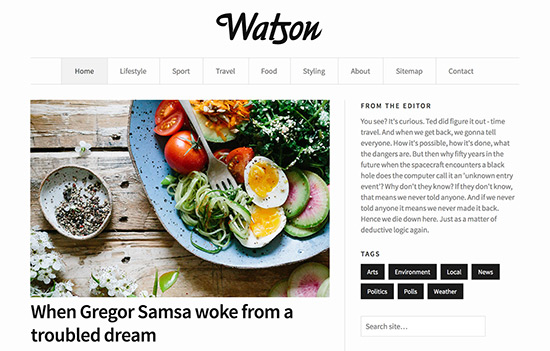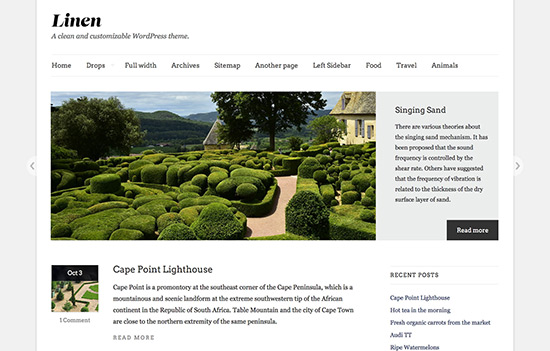Selecting an effective business WordPress theme
By team on November 6, 2014
Identifying the perfect WordPress theme for your business website requires time, tenacity, and – this one might surprise you – restraint.
While there’s a seemingly endless array of gorgeous WordPress themes at your disposal, choosing one isn’t a decision you should base solely on aesthetics. A business website, after all, doesn’t exist just to look nice; it’s a tool that should help you generate revenue.
With that sentiment in mind, let’s examine some ways to align your WordPress theme choices with real business objectives. Here are the questions you will need to answer:
Who is my audience and how can I help them?
Imagine you own a bike shop. Last year, you picked a business WordPress theme you thought was attractive, activated it, and added some content. As far as you could tell, the website was fine.
Until you started talking to customers.
As it turns out, many people coming to your shop for the first time had trouble locating it. Some of them even had to call their cycling buddies to ask where the shop was. Everyone found the website without any trouble, but for some reason, they couldn’t find you!
In response to their feedback, you decided to make the shop’s contact information more prominent on the site. Your WordPress theme, presumably built for retailers, included an About page template with a space for your business address. You had initially put the address there, but you decided to switch to a new theme that reserved space for the business address in the header – so it would appear at the top of every page.
Before long, more new customers started coming in. You also got more calls about bike merchandise and repair services, all because of a simple change to your design.
While you might not own a bike shop in real life, the takeaways from this scenario apply to any business website:
-
Assumptions about your audience aren’t always adequate. Your design choices may make sense to you, but whether they makes sense to your audience is a separate issue.
-
The more you know about your audience, the more you can help them. By taking the time to learn about your audience, you’ll discover what they need most. Doing this takes effort, but the results make it worthwhile.
Ultimately, audience needs should play a significant role in helping you choose a theme for your business website. The better you know your audience, the more effective your choice of a WordPress theme will be. In contrast, failing to think about your audience risks subjecting them to a design that is difficult to use or makes it hard to locate relevant information.
But how can small businesses, freelancers, and bloggers gain a better understanding of their audiences beyond making plausible assumptions? Here are some ways:
- Google Analytics: Seeing how people use your website can help you pinpoint which elements of your design are helping them find the information they need – and which ones aren’t.
- Keyword Planner: You will need a Google Adwords account to use this tool. Once you gain access, you’ll be able to see, at a glance, the precise diction your audience uses when searching for content like yours. Yes, SEO is an excellent way to help your audience find the information they need! But if your current theme doesn’t facilitate SEO best practices, it might be time to reevaluate your design.
- Heat mapping tools: Applications like CrazyEgg and ClickTale can help you visualize the parts of your site most frequently seen and accessed by users. If, for example, you observe that users rarely scroll past the middle of your home page, you can choose a theme that places your most important content where they’re most likely to encounter it.
Once a privilege reserved for big companies with big marketing budgets, user research is now available to the masses! For some more nuanced advice about using these tools and others to conduct quality user research, check out designer and UX evangelist Christopher Myhill’s article about “guerrilla” research tactics.
What business goals should my website address?
If you’ve never identified the precise action (or actions) people should take upon visiting your website, you should start thinking about it now. Ultimately, the purpose of a business website is to enlist users into some sort of sales process. The action you encourage them to take should relate to the stage of the sales process into which you want them to advance. Examples include:
- Making a purchase: E-commerce websites that encourage users to buy something often employ “Add to cart” or “Buy now” calls to action (CTAs) so that it’s clear what users should do.
- Filling out a contact form: Service providers may want users to reach out for a consultation or an estimate. “Contact us” or “Get in touch” are common CTAs.
- Joining a mailing list or dropping by for a visit: From brick-and-mortar stores to churches and civic groups, many organizations just want to get people in the door or expose them to more content. “Visit us” or “Join us” are common CTAs. So is “Sign up” if you want people to join a mailing list.
When it comes to your WordPress theme, you should make it as seamless as possible for people to respond to your CTA. The thing is, not all themes are suited to all types of business goals. Our portfolio theme, Bailey, might be a great option for showcasing creative work, but it would be difficult to turn it into a full-fledged e-commerce powerhouse! For that, we’ll suggest Make instead.
By thinking about business goals before choosing a theme, you’ll be able to search for designs that help you move users through your sales process – not inhibit you from earning new business.
What content will help me address audience needs and business goals?
If you’ve gotten to know your audience and identified business goals, the next step is determining what kind of content will speak to both points. In other words, your content should inform your WordPress theme selection, not the other way around.
And yes, this often means creating your content before committing to a theme!
In his article, Designing Content First for a Better UX, content strategist Liam King argues that one should, at the very least, “roll” his or her content before committing to certain design elements. The idea is that you don’t have to craft the perfect, final version of your content, but you should at least prepare something similar to the actual message you need to communicate (remember: audience needs + business goals). That way, you know what sort of design will make the message shine.
Some popular design elements may not make your message shine, and they should be avoided. If, for instance, you can’t determine any possible scenario in which a home page slider helps your audience and/or addresses a specific business goal, you should probably avoid themes that force you to place content in a slider.
The same goes for themes with static sidebars. What if Google Analytics data reveals that around 35% of your audience arrives to your site via mobile device? You probably shouldn’t use a theme that places important content in a sidebar by default. Your audience may never see the content without scrolling to the bottom of the screen!
Designing for business means prioritizing business results
Fundamentally, business websites exist to further business objectives. By determining what those objectives are, studying your audience, and preparing useful content based on meaningful insights, you’ll be ready to select the right WordPress theme.
We’re not saying these exercises aren’t time-consuming. In many cases, they are! That’s where the “restraint” we were talking about comes into play. Making a hasty decision about your WordPress theme could result in buyer’s (or publisher’s) remorse. Instead, make yours a well-informed business decision – we think you’ll be glad you did.
By the way, if you’re looking for discounts on popular themes be sure to check out these perfect WordPress theme deals.
What’s the most significant thing you’ve done to improve results from your business website? Let us know on Twitter or in the comments below!
Enjoy this post? Read more like it in Business.






